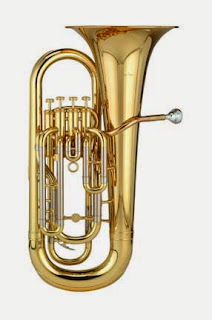The euphonium is a valved brass instrument, the tenor member of the tuba family. The appearance of a euphonium is very similar to that of a tuba, and many people not familiar with the instrument sometimes incorrectly call it a tuba.
Like the tuba, the euphonium has a bore that constantly increases in size from the valve section to the bell - this is called "conical bore", as distinguished from "cylindrical bore" instruments, which maintain a constant tubing diameter for a greater portion of the instrument's total length. Thus, even though the euphonium plays in the same range of pitches as the trombone (with a cylidrical bore), it has a more mellow, "rounder" sound than the "brassier" sound of a trombone. This is similar to the difference between the cornet and the trumpet.
Typically, a euphonium has four valves. Each valve increases the length of the entire instrument when pressed down, according to the length of the tuning slide attached to it. The order of length from shortest to longest is 2, 1, 3, 4. The 4th valve is about the same length as valves 1 and 3 combined. The 4th valve exists because it is slightly more in tune in some contexts than valves 1 and 3 combined. Valve 4 also allows for a player to play in the lower register, by adding more tubing than the usual 3-valve instrument's limit. Some euphoniums also include 'compensating systems', consisting of extra tubing in the fourth valve. These both improve the stability of the instrument's sound in the lower ranges and allow the player to play in those ranges using more conventional fingerings.
Instruments similar to the euphonium include the American-style baritone horn, the British baritone (which, being a saxhorn, is more cylindrical and trombone-like than the American baritone), and the German baryton and tenorhorn. All trace their descent to the serpent. A unique American creation was the double-belled euphonium, which featured a second, smaller bell and an extra valve allowing the player to use that bell instead of the main bell. The second bell had a more trombone-like sound.
The euphonium is most commonly found in wind bands of various kinds, such as concert bands, brass bands, marching bands, and military bands, where it is frequently featured as a solo instrument. It is also often used today in brass ensembles/choirs. It is not traditionally an orchestral instrument and thus is not found in modern symphony orchestras. Only for certain works where the composer specifically requested it is a euphonium (or "tenor tuba") used in orchestras (such as in Holst's Planets Suite). The name "euphonium" comes from the Greek word "euphonion", meaning "beautiful-sounding" or "sweet-voiced".






